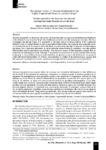Use este identificador para citar ou linkar para este item:
http://www.alice.cnptia.embrapa.br/alice/handle/doc/658356Registro completo de metadados
| Campo DC | Valor | Idioma |
|---|---|---|
| dc.contributor.author | RUSCHEL, A. R. | pt_BR |
| dc.contributor.author | BERNARD, F. | pt_BR |
| dc.contributor.author | NODARI, R. O. | pt_BR |
| dc.contributor.author | MOERSCHBACHER, B. M. | pt_BR |
| dc.date.accessioned | 2011-04-10T11:11:11Z | pt_BR |
| dc.date.available | 2011-04-10T11:11:11Z | pt_BR |
| dc.date.created | 2010-02-22 | pt_BR |
| dc.date.issued | 2009 | pt_BR |
| dc.identifier.citation | Scientia Forestalis, Piracicaba, v. 37, n. 82, p. 151-161, jun. 2009. | pt_BR |
| dc.identifier.uri | http://www.alice.cnptia.embrapa.br/alice/handle/doc/658356 | pt_BR |
| dc.description | Sorocea bonplandii is a dioecious sub canopy plant species with an abundant and widespread distribution in the Atlantic Forest, Southern Brazil. It is traditionally used for art crafts and popular medicine. We have investigated the genetic status of S. bonplandii in one large and six small populations of the fragmented Atlantic Forest in southern Brazil. In spite of population fragmentation, the allozyme electrophoretic analysis involving 23 loci of 12 enzymes from 420 plants revealed unusually high frequencies of heterozygous genotypes and a balanced distribution, in agreement with Hardy-Weinberg proportions. Very little genetic differentiation among populations was detected. The observed excess of heterozygotes suggests that selection favors heterozygous plants. Although S. bonplandii is a dominant sub-canopy species which strongly depends on ombrophilous environmental conditions, its genetic structure and diversity do not appear to suffer with forest fragmentation. All of these characteristics, in addition to its medicinal uses, suggest that this species is a potential resource for sustainable management of tropical forests in southern Brazil. | pt_BR |
| dc.language.iso | eng | eng |
| dc.rights | openAccess | eng |
| dc.subject | Allozyme diversity | pt_BR |
| dc.subject | Heterozygotes | pt_BR |
| dc.subject | Subtropical Atlantic Forest | pt_BR |
| dc.title | The genetic status of Sorocea bonplandii in the highly fragmented forest in southern Brazil. | pt_BR |
| dc.type | Artigo de periódico | pt_BR |
| dc.date.updated | 2015-02-02T11:11:11Z | pt_BR |
| riaa.ainfo.id | 658356 | pt_BR |
| riaa.ainfo.lastupdate | 2015-02-02 | pt_BR |
| dc.contributor.institution | ADEMIR ROBERTO RUSCHEL, CPATU; Frank Bernard, University of Münster; Rubens Onofre Nodari, UFSC; Bruno Maria Moerschbacher, University of Münster. | pt_BR |
| Aparece nas coleções: | Artigo em periódico indexado (CPATU)  | |
Arquivos associados a este item:
| Arquivo | Descrição | Tamanho | Formato | |
|---|---|---|---|---|
| Id42672.pdf | 809,57 kB | Adobe PDF |  Visualizar/Abrir |









